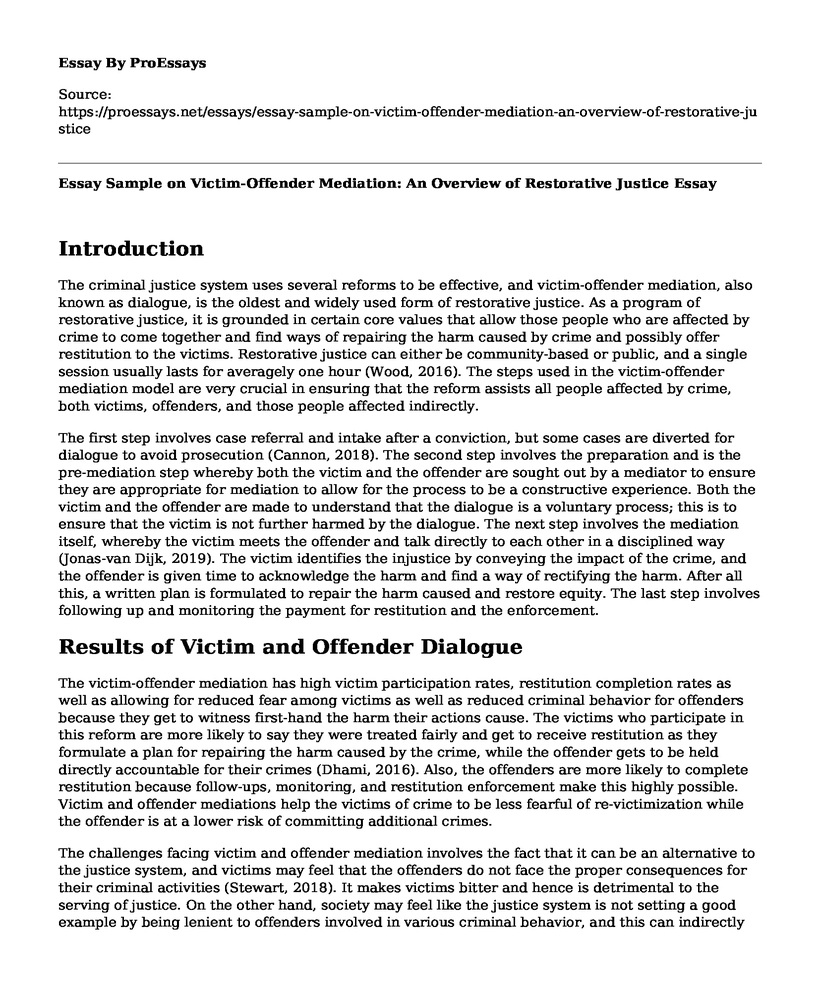Introduction
The criminal justice system uses several reforms to be effective, and victim-offender mediation, also known as dialogue, is the oldest and widely used form of restorative justice. As a program of restorative justice, it is grounded in certain core values that allow those people who are affected by crime to come together and find ways of repairing the harm caused by crime and possibly offer restitution to the victims. Restorative justice can either be community-based or public, and a single session usually lasts for averagely one hour (Wood, 2016). The steps used in the victim-offender mediation model are very crucial in ensuring that the reform assists all people affected by crime, both victims, offenders, and those people affected indirectly.
The first step involves case referral and intake after a conviction, but some cases are diverted for dialogue to avoid prosecution (Cannon, 2018). The second step involves the preparation and is the pre-mediation step whereby both the victim and the offender are sought out by a mediator to ensure they are appropriate for mediation to allow for the process to be a constructive experience. Both the victim and the offender are made to understand that the dialogue is a voluntary process; this is to ensure that the victim is not further harmed by the dialogue. The next step involves the mediation itself, whereby the victim meets the offender and talk directly to each other in a disciplined way (Jonas-van Dijk, 2019). The victim identifies the injustice by conveying the impact of the crime, and the offender is given time to acknowledge the harm and find a way of rectifying the harm. After all this, a written plan is formulated to repair the harm caused and restore equity. The last step involves following up and monitoring the payment for restitution and the enforcement.
Results of Victim and Offender Dialogue
The victim-offender mediation has high victim participation rates, restitution completion rates as well as allowing for reduced fear among victims as well as reduced criminal behavior for offenders because they get to witness first-hand the harm their actions cause. The victims who participate in this reform are more likely to say they were treated fairly and get to receive restitution as they formulate a plan for repairing the harm caused by the crime, while the offender gets to be held directly accountable for their crimes (Dhami, 2016). Also, the offenders are more likely to complete restitution because follow-ups, monitoring, and restitution enforcement make this highly possible. Victim and offender mediations help the victims of crime to be less fearful of re-victimization while the offender is at a lower risk of committing additional crimes.
The challenges facing victim and offender mediation involves the fact that it can be an alternative to the justice system, and victims may feel that the offenders do not face the proper consequences for their criminal activities (Stewart, 2018). It makes victims bitter and hence is detrimental to the serving of justice. On the other hand, society may feel like the justice system is not setting a good example by being lenient to offenders involved in various criminal behavior, and this can indirectly promote crime (Hansen, 2018). Such challenges can be solved by ensuring that the offender goes through the normal process of prosecution for any crime committed, after which they can be given a chance to repair the harm caused by their criminal behavior. It is because prosecution and conviction do not entirely repair the harm caused by crime and only serve justice and restitution to the victims. The victim-offender mediation covers all people affected by the crime, whether directly or indirectly, and the dialogue builds trust between the different parties involved in the criminal activity.
References
Cannon, B. (2018). Confidentiality in Victim-Offender Mediation: How Confidential is Confidential. Resolved: J. Alternative Disp. Resol., 7, 3.
Dhami, M. K. (2016). Apology in victim-offender mediation. Contemporary justice review, 19(1), 31-42.
Hansen, T., & Umbreit, M. (2018). State of knowledge: Four decades of victimoffender mediation research and practice: The evidence. Conflict Resolution Quarterly, 36(2), 99-113.
Jonas-van Dijk, J., Zebel, S., Claessen, J., & Nelen, H. (2019). Victim-Offender Mediation and Reduced Reoffending: Gauging the Self-Selection Bias. Crime & Delinquency, 0011128719854348.
Stewart, L., Thompson, J., Beaudette, J. N., Buck, M., Laframboise, R., & Petrellis, T. (2018). The impact of participation in victim-offender mediation sessions on recidivism of serious offenders. International journal of offender therapy and comparative criminology, 62(12), 3910-3927.
Wood, W. R., & Suzuki, M. (2016). Four challenges in the future of restorative justice. Victims & Offenders, 11(1), 149-172.
Cite this page
Essay Sample on Victim-Offender Mediation: An Overview of Restorative Justice. (2023, Feb 27). Retrieved from https://proessays.net/essays/essay-sample-on-victim-offender-mediation-an-overview-of-restorative-justice
If you are the original author of this essay and no longer wish to have it published on the ProEssays website, please click below to request its removal:
- Adolescent Development and Judicial System
- Paper Example on Types of Witnesses
- Essay Sample on Sentencing Disparities
- Is It Misleading to Label a Crime as "Victimless" Essay
- Case Study on Frye v United States and Daubert's Case
- Exploring Cybercrime: Cyberpiracy, Cybertrespass & Cyber-Vandalism - Essay Sample
- Offenders in Jails - Report Example







